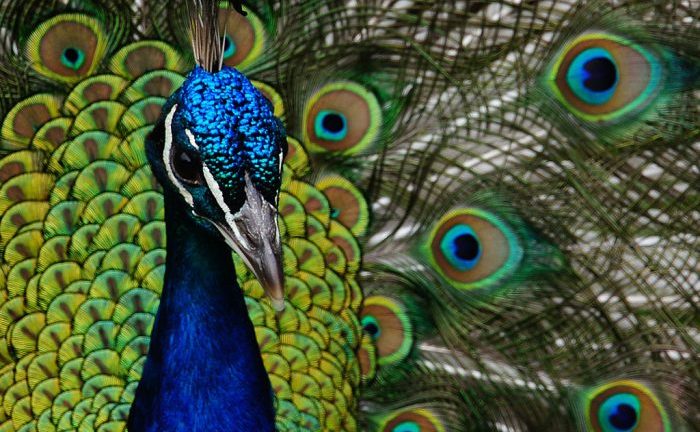Pakistan, with its diverse topography and rich wildlife, is home to a wide range of bird species. From majestic eagles to colorful parrots and tiny hummingbirds, the country’s avian population is both fascinating and beautiful. In this blog post, we will take a closer look at the various species of birds in Pakistan. We will explore the unique features and characteristics of each species, including their habitat, diet, and behavior.
We will also discuss the efforts being made to protect and conserve these bird species, as many of them are facing threats such as habitat loss, pollution, and climate change. From conservation programs to bird sanctuaries and protected areas, we will highlight the initiatives being undertaken to ensure the survival of these magnificent creatures.
In addition, we will discuss the role that birds play in the ecosystem, from pollination to pest control and their importance in maintaining the balance of nature.
Whether you are a bird enthusiast or simply curious about avian life in Pakistan, this blog post will provide you with a fascinating insight into the diverse and vibrant bird species that call the country home.
List of Species of birds in Pakistan
- House Sparrow
- Eurasian Collared Dove
- Indian Robin
- Common Myna
- Red-vented Bulbul
- Common Kestrel
- Black Kite
- Indian Peafowl
- White-throated Kingfisher
- Rose-ringed Parakeet
- Indian Cormorant
- Little Egret
- Cattle Egret
- Grey Heron
- Steppe Eagle
- Common Buzzard
- Black-winged Stilt
- Red-wattled Lapwing
- Rock Pigeon
- Eurasian Magpie
House Sparrow
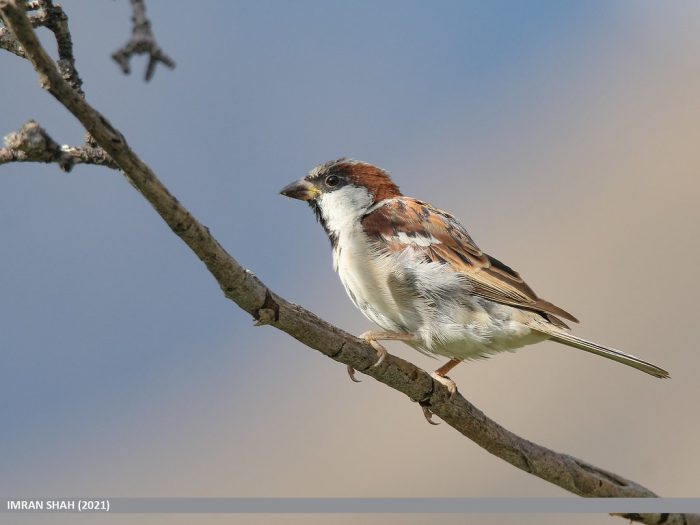
Image Source
The House Sparrow, also known as the common sparrow, is a small bird species that are found throughout Pakistan. They are known for their brownish-grey feathers, black bib, and characteristic chirping calls.
House Sparrows are commonly found in urban areas, where they can be seen perching on rooftops, buildings, and telephone wires. They are social birds and can often be found in flocks. House Sparrows are omnivores and feed on a variety of foods, including seeds, insects, and even human food scraps.
In recent years, the House Sparrow population has declined in many parts of the world, including Pakistan. This decline has been attributed to factors such as loss of habitat, pollution, and changes in agricultural practices.
Efforts are being made to conserve the House Sparrow population in Pakistan through initiatives such as creating artificial nesting sites and promoting awareness about their importance in the ecosystem.
Also Read: Birds with Crest
Eurasian Collared Dove
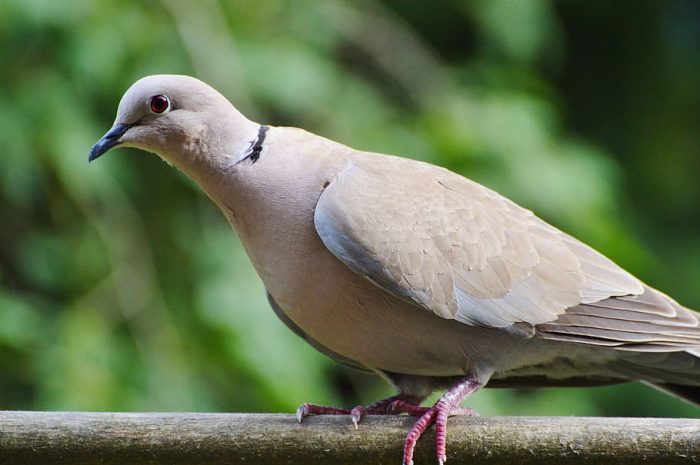
Image Source
The Eurasian Collared Dove (Streptopelia decaocto) is a bird species that is found in Pakistan, as well as across Europe, Asia, and parts of Africa. This dove species has a distinctive black collar around its neck, which gives it its name.
Eurasian Collared Doves are typically around 32 centimeters in length, and their wingspan can reach up to 62 centimeters. They have a grey-brown body with a lighter underbelly, and their wings have a black stripe along the edge. Their eyes are surrounded by a small area of blue skin, and they have a long, pointed tails.
These doves are common in both urban and rural areas, and they are often found near human settlements such as cities, towns, and villages. They feed on a variety of seeds, grains, and fruits, and can often be seen foraging on the ground or perched in trees. They are known for their soft cooing calls, which can often be heard in the early morning and evening.
Eurasian Collared Doves are monogamous and form strong pair bonds. They build their nests in trees, on buildings, or in other structures, using twigs and grasses. The female lays 2-3 eggs, which both parents take turns incubating for around 14 days. The chicks hatch with white downy feathers and are fed crop milk, a special secretion produced by the parents. The chicks fledge after around 15-19 days and become independent after a few weeks.
While Eurasian Collared Doves are not considered endangered, their populations have increased rapidly since their introduction to new areas in the 20th century. They are considered an invasive species in some parts of the world, including the United States. However, in Pakistan, they are a common and beloved sight in both urban and rural areas.
Indian Robin Birds in Pakistan
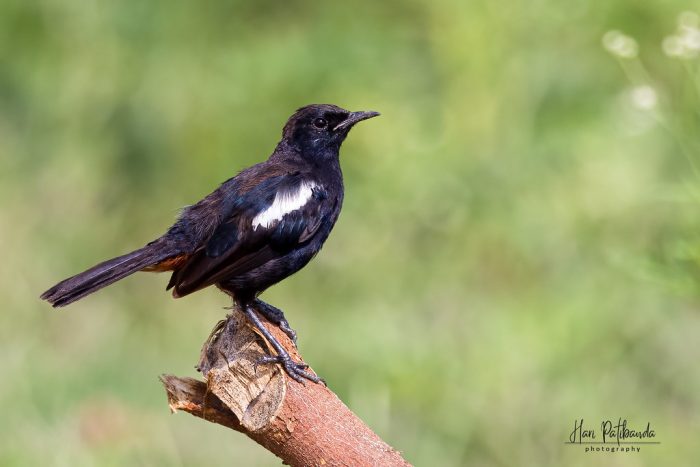
Image Source
The Indian Robin (Saxicoloides fulicata) is a species of bird that is commonly found in Pakistan. It belongs to the family Muscicapidae, which includes other species such as thrushes, chats, and flycatchers.
The Indian Robin is a small bird that typically measures around 15 centimeters in length. The males have a distinctive black head, neck, and upper back, while the lower back and tail are a bright orange-red color. The wings and breast are pale gray, and the belly is white. Females have a duller coloration with a gray-brown head and back, and a reddish-brown tail. Both males and females have a distinctive white patch on the wing.
The Indian Robin is a resident bird found in a variety of habitats including open woodlands, scrubland, and agricultural areas. It is commonly found in gardens and parks, and often seen perched on wires or fences. The bird feeds on insects and small invertebrates such as beetles, ants, and termites, as well as fruits and seeds.
The Indian Robin is known for its beautiful song, which consists of a series of melodious whistles and trills. The male often sings from an exposed perch, such as the top of a tree or a rooftop, to attract a mate or establish his territory. The species is also known for its distinctive courtship behavior, where the male performs a series of aerial displays and calls to attract a female.
Common Myna
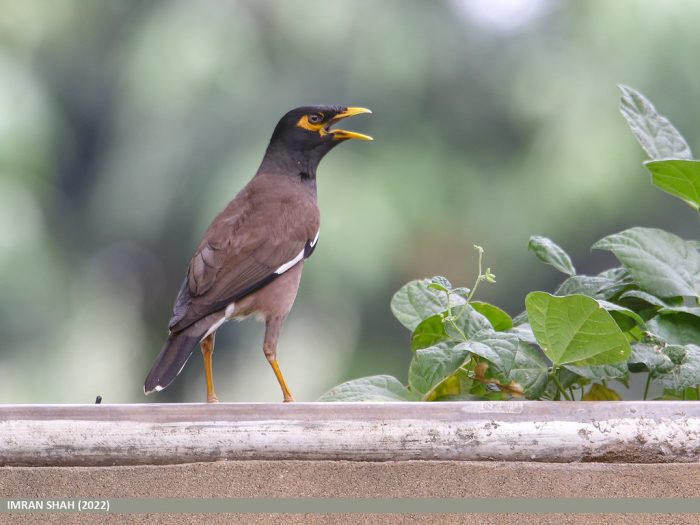
Image Source
The Common Myna (Acridotheres tristis) is a well-known bird species found in Pakistan, as well as in many parts of Asia. It is also commonly known as the Indian Myna, as it is native to the Indian subcontinent.
The Common Myna is a medium-sized bird, measuring about 23 cm in length. It has a brownish-grey body with a black head, neck, and wings. The eyes are yellow, and the bill and legs are bright yellow. The bird has a distinctive yellow patch of skin around the eyes. The tail is long and brown, with a white tip. Both males and females look similar.
This bird is highly adaptable and can be found in a variety of habitats, including urban areas, rural farmland, and forests. It feeds on a wide range of foods, including insects, fruits, and grains. It is also known to scavenge in garbage dumps and feed on human food scraps.
The Common Myna is known for its distinctive and loud call, which is a series of whistles, warbles, and cackles. It is an intelligent bird and can mimic a variety of sounds, including human speech.
In Pakistan, the Common Myna is a common sight in cities and towns, where it often nests in buildings and other man-made structures. It is considered a pest in some areas due to its habit of raiding crops and damaging fruit trees. Despite this, it is a beloved bird and has become a part of the cultural heritage of Pakistan, featuring in folklore, poetry, and literature.
Red-vented Bulbul
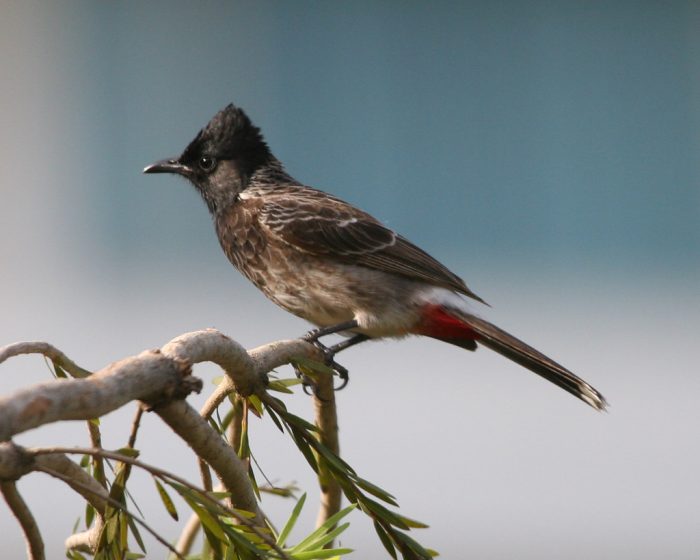
Image Source
The Red-vented Bulbul, also known as the Red-vented or Red-whiskered Bulbul, is a common bird species found in Pakistan. This bird species is part of the bulbul family and is easily recognizable by its distinctive red-colored patch beneath its tail.
The Red-vented Bulbul has a plump body, a short neck, and a relatively long tail. It has a black or dark brown head, neck, and upper body, and a cream or light-colored belly. The bird’s most distinctive feature is the bright red patch located beneath its tail, which is visible when the bird is in flight or perched.
These birds are found in a variety of habitats including gardens, parks, woodlands, and open areas with shrubs and trees. They feed mainly on fruits, nectar, insects, and small invertebrates. Red-vented Bulbuls are known to be very social birds and are often found in groups or pairs.
The Red-vented Bulbul is a resident bird and breeds throughout the year in Pakistan. Its nest is typically a cup-shaped structure made of twigs, grass, and other plant materials, and is often found in shrubs or trees. The female lays 2-5 eggs and both parents take turns incubating them.
Also Read: Birds with Mud Nest
Common Kestrel
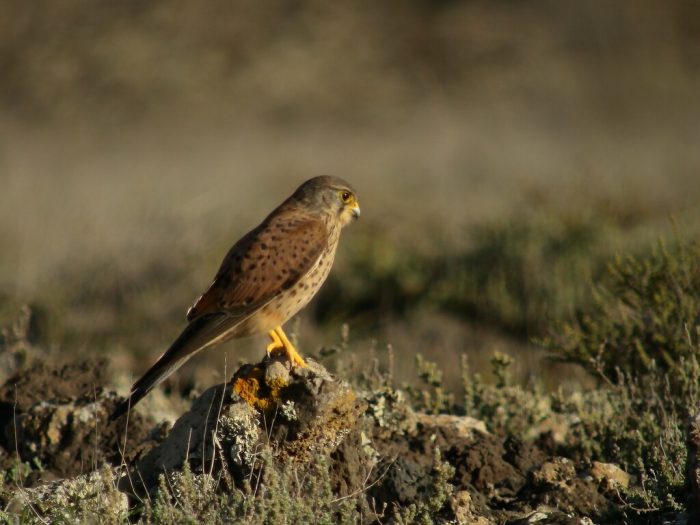
Image Source
The Common Kestrel (Falco tinnunculus) is a small falcon that is widespread in Pakistan. It is a bird of prey that is known for its distinctive hovering flight, where it remains stationary in mid-air while scanning the ground for prey.
The Common Kestrel is a medium-sized bird of prey, with a wingspan of around 60-70 cm. The male has a grey head and tail, with a reddish-brown back and wings, and a cream-colored underbelly with black spots. The female is similar in appearance, but has a larger body and lacks the blue-grey head of the male.
In Pakistan, the Common Kestrel can be found in a variety of habitats, including farmland, open countryside, and urban areas. It feeds mainly on small mammals such as rodents, as well as insects, reptiles, and occasionally small birds.
The Common Kestrel is a resident breeder in Pakistan, and can often be seen perched on telephone poles or other elevated positions while searching for prey. Its population is generally considered stable, although habitat loss and persecution by humans can pose a threat to its survival.
Black Kite
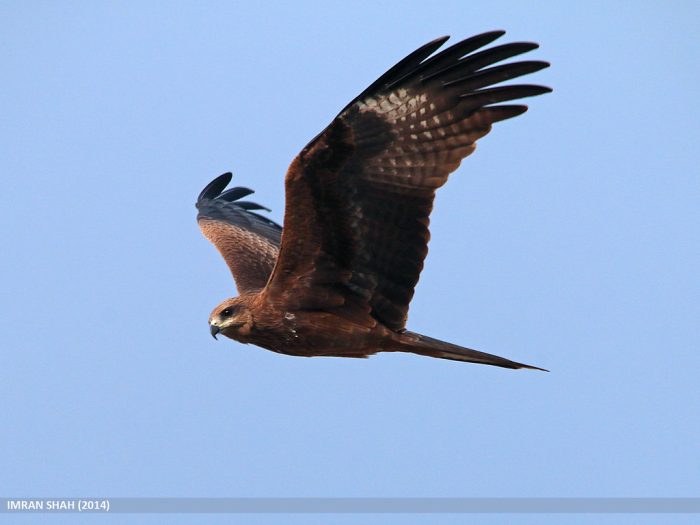
Image Source
The Black Kite (Milvus migrans) is a common bird of prey species found in Pakistan. It is also known as the “Pariah Kite” or “Cape Kite”. This medium-sized bird of prey is easily recognizable by its forked tail and long wings. Its plumage is predominantly brown, with lighter coloring on the head and neck.
Black Kites are found in a variety of habitats, including urban areas, grasslands, and forests. They feed on a wide range of prey, including small mammals, birds, insects, and carrion. They are also known to scavenge for food and can often be seen around garbage dumps or open-air markets.
During the breeding season, Black Kites build their nests in trees or on man-made structures such as buildings or electrical pylons. They lay 2-4 eggs, which are incubated for around a month. The young birds fledge around 6-7 weeks after hatching.
Black Kites are common throughout Pakistan and are considered a valuable part of the ecosystem. They help to control pest populations and also play an important role in nutrient cycling by scavenging for carrion. However, like many bird species, they face threats such as habitat loss and pollution, and conservation efforts are needed to ensure their long-term survival.
Indian Peafowl

Image Source
The Indian Peafowl, also known as the peacock, is a large and beautiful bird that is native to South Asia, including Pakistan. The male of the species is known for its vibrant blue-green plumage, with a distinctive fan-like crest of feathers on its head, while the female, or peahen, has a more subdued brownish plumage. The male’s striking appearance is used to attract mates during the breeding season, and its courtship display involves fanning out its tail feathers and performing a dance.
Indian Peafowl is found in a variety of habitats, including forests, grasslands, and agricultural fields, and they are often seen in rural areas of Pakistan. They are omnivorous, feeding on a variety of insects, plants, and small animals, and are known to cause damage to crops in some areas. In Pakistan, the Indian Peafowl is considered a national bird and is protected by law.
The Indian Peafowl has a long history of association with Indian and Pakistani culture, where it is often depicted in art and literature. Its striking appearance and unique behaviors have also made it a popular bird in zoos and parks around the world. However, conservation efforts are needed to protect wild populations, which are threatened by habitat loss and hunting.
White-throated Kingfisher
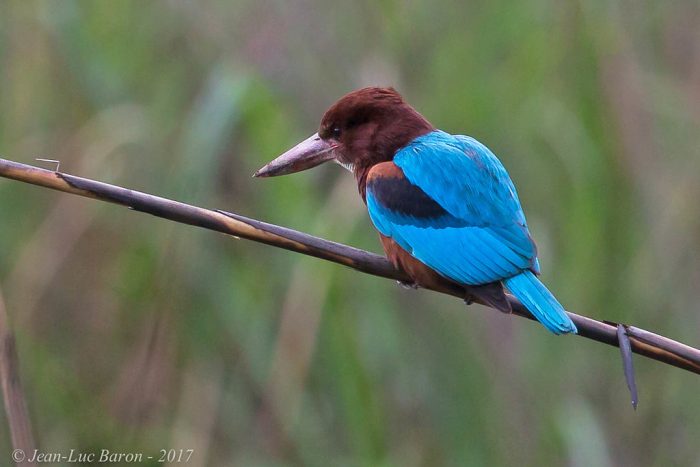
Image Source
The White-throated Kingfisher (Halcyon smyrnensis) is a common resident bird species found throughout Pakistan and is considered one of the most colorful and attractive birds in the country. This bird belongs to the family of Alcedinidae and is characterized by its bright blue and chestnut plumage, with a distinctive white patch on its throat. It has a large head, a long, thick, red beak, and strong legs, and can grow up to 28 centimeters in length.
The White-throated Kingfisher is found in a wide range of habitats, including woodlands, forests, agricultural areas, and urban parks and gardens. They are often seen perched on branches, wires, or poles, scanning the surrounding areas for their prey, which mainly consists of small reptiles, insects, crustaceans, and occasionally small mammals and birds.
The White-throated Kingfisher is known for its distinctive and melodious call, which is a loud and clear “pi-pi-pi-pi-pi-pi-pi-pi-pi-pi.” They are also known for their spectacular hunting techniques, which involve diving from a high perch to capture their prey with their sharp beaks. They are active during the day and rest at night in their nests, which are usually located in holes in trees, banks, or walls.
Due to its striking appearance and distinctive calls, the White-throated Kingfisher is a popular bird for birdwatchers and photographers in Pakistan. It is also considered an important cultural symbol in many South Asian countries and is often associated with good luck and prosperity.
Rose-ringed Parakeet
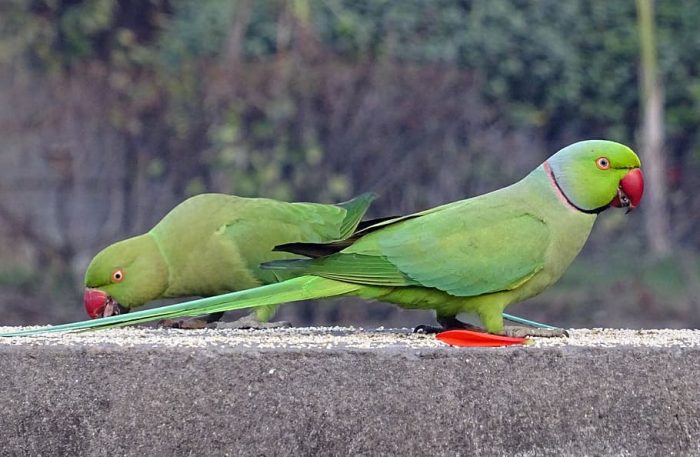
Image Source
The Rose-ringed Parakeet, also known as the Ring-necked Parakeet, is a species of parrot that is native to the Indian subcontinent and parts of Southeast Asia. It has also been introduced to many other parts of the world, including Pakistan.
In Pakistan, the Rose-ringed Parakeet is a common bird that is found in urban and suburban areas, especially in parks and gardens. The male and female birds look similar, with green bodies and long tails. The male bird has a distinctive black and rose-colored collar around its neck.
These birds are known for their loud, raucous calls, and can often be heard before they are seen. They are social birds and can be seen in flocks of up to 50 individuals, sometimes more. They feed on a variety of fruits, seeds, and grains, and are known to raid crops, orchards, and gardens.
In addition to their vibrant colors and noisy calls, the Rose-ringed Parakeet is also known for its ability to mimic human speech. As a result, they are sometimes kept as pets. However, in Pakistan, it is illegal to keep them as pets without a permit from the government. Overall, the Rose-ringed Parakeet is a fascinating and charismatic bird that adds to the colorful avian diversity of Pakistan.
Also Read: Birds with Big Mouths
Indian Cormorant Birds in Pakistan
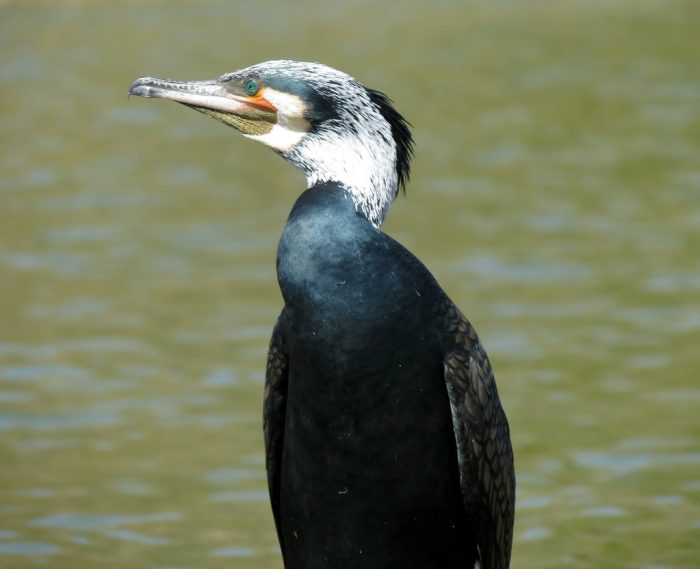
Image Source
The Indian Cormorant, also known as the Indian Shag, is a bird species found in Pakistan and other parts of the Indian subcontinent. It belongs to the family of Phalacrocoracidae, which are seabirds that inhabit coastal areas and inland water bodies such as lakes and rivers.
The Indian Cormorant is a medium-sized bird with blackish-brown plumage, a slender neck, and a slightly curved beak. It has a distinctive white patch on its thigh, which distinguishes it from other cormorant species found in the region. Its wingspan can reach up to 90 cm.
Indian Cormorants are often seen perched on trees or rocks, with their wings spread out to dry after diving into the water to catch fish. They are skilled divers and swimmers, able to hold their breath for several minutes while underwater. They feed on a variety of fish, eels, and other aquatic creatures.
During the breeding season, Indian Cormorants gather in large colonies and build their nests on trees near water bodies. They lay 2-4 eggs, which hatch after about a month. Both parents take turns incubating the eggs and caring for the young chicks.
Despite being a common sight in Pakistan, the Indian Cormorant is facing threats such as habitat loss, pollution, and human disturbance. Conservation efforts are necessary to ensure the survival of this species and its vital role in maintaining the ecological balance of coastal and inland water ecosystems.
Little Egret
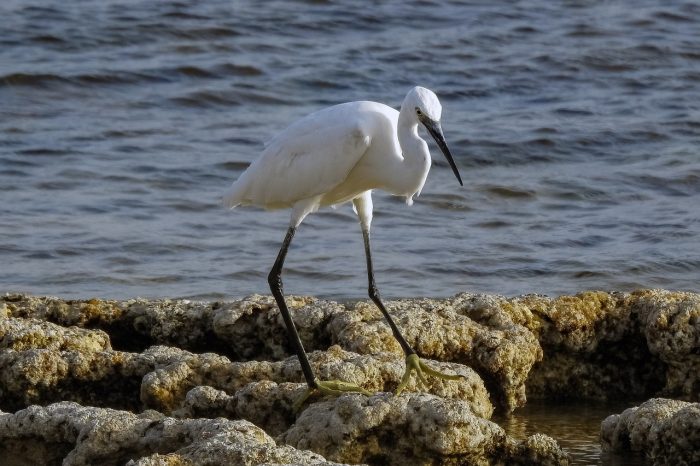
Image Source
The Little Egret, also known as the Western Reef Egret, is a small white heron that can be found in many parts of Pakistan. This elegant bird is known for its striking white plumage, slender black legs, and bright yellow feet. It also has a long, pointed black bill that is used for hunting small fish, crustaceans, and insects.
In Pakistan, Little Egrets can be found near freshwater sources such as lakes, rivers, and wetlands. They are also known to inhabit agricultural areas and even urban environments, where they can be seen foraging in small ponds and streams.
Little Egrets are highly adaptable birds and are known to adjust their feeding behavior according to the available food sources. They can be seen wading in shallow waters, patiently waiting for fish to swim by before quickly snatching them up with their sharp bill. They are also known to use their feet to stir up the water and flush out small crustaceans and insects.
During the breeding season, Little Egrets can be seen nesting in colonies in tall trees near water sources. The female lays two to four eggs and both parents take turns incubating them until they hatch. Once the chicks hatch, they are fed regurgitated food by their parents until they are old enough to forage on their own.
Cattle Egret
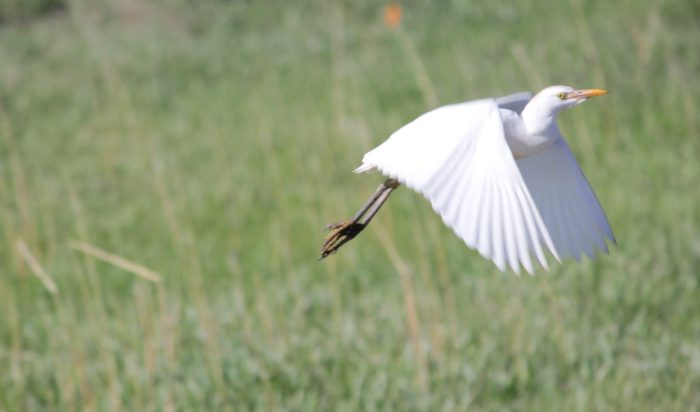
Image Source
Cattle Egret, also known as Bubulcus ibis, is a small, white heron species found throughout Pakistan. They are relatively common and widespread in their distribution across the country, from wetlands to agricultural fields and even urban areas.
Cattle Egrets are about 46-56 cm in length and have a wingspan of 88-96 cm. They have a white body with short, yellow legs and a yellow bill. During the breeding season, they develop orange-buff plumes on their head, neck, and back.
As their name suggests, Cattle Egrets are often seen foraging around cattle and other livestock, feeding on insects and small invertebrates that are disturbed by the grazing animals. They are also known to follow tractors and other farm machinery to catch prey that is stirred up by the equipment.
During the breeding season, Cattle Egrets form colonies in trees and shrubs, where they build their nests out of sticks and other plant material. They typically lay 3-4 eggs, which hatch after about 20-25 days of incubation.
Cattle Egrets are considered to be of the least concern in terms of conservation status, as their population is stable and not under significant threat. They are a common sight in many parts of Pakistan and are appreciated for their pest control services in agricultural areas.
Grey Heron

Image Source
The Grey Heron is a large wading bird that is commonly found in Pakistan, especially near water bodies such as rivers, lakes, and wetlands. It is a resident bird, and some populations also migrate to Pakistan during winter.
The Grey Heron has distinctive grey plumage, a long neck, and a long, sharp bill that it uses to catch fish, frogs, and other small prey. It stands around 1 meter tall and has a wingspan of around 1.8 meters.
In Pakistan, the Grey Heron is often found near water bodies such as the Indus River, the Manchar Lake, and the Keenjhar Lake. They are solitary birds and can often be seen standing motionless for long periods of time while waiting for their prey. Grey Herons are also known to roost in large numbers in trees near water bodies.
The Grey Heron plays an important role in Pakistan’s ecosystem by helping to control fish and frog populations. They are also a popular subject for birdwatchers and nature enthusiasts due to their impressive size and striking appearance.
Steppe Eagle

Image Source
The Steppe Eagle (Aquila nipalensis) is a large bird of prey that is found in Pakistan, as well as in many other parts of Asia and Eastern Europe. These birds are typically found in open grasslands, savannas, and deserts.
Steppe Eagles are large birds, with a wingspan of up to 7 feet (2.1 meters) and a body length of up to 3 feet (90 cm). They have dark brown feathers on their upper bodies and wings, with lighter feathers on their heads and necks. Their underparts are generally light-colored, with some birds having reddish-brown feathers on their bellies.
These birds primarily feed on small mammals like rodents and hares, as well as birds, reptiles, and even insects. They are also known to scavenge carrion and will feed on livestock and poultry if given the opportunity.
In Pakistan, the Steppe Eagle is a common winter visitor, with many birds coming from their breeding grounds in Siberia and Central Asia to spend the colder months in Pakistan’s warmer climate. They are often seen soaring high in the sky, using their keen eyesight to spot prey on the ground below.
The Steppe Eagle is considered a near-threatened species due to habitat loss and hunting pressures, and efforts are underway to conserve their populations across their range.
Common Buzzard
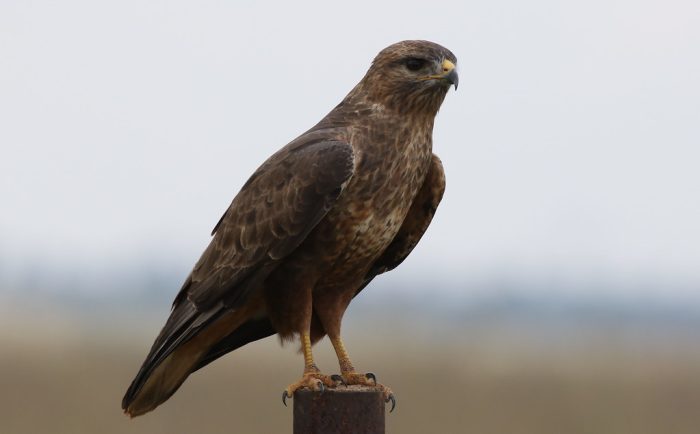
Image Source
The Common Buzzard (Buteo buteo) is a medium-sized bird of prey that is found in Pakistan. It belongs to the family Accipitridae, which includes other birds of prey such as eagles, hawks, and kites.
The Common Buzzard is a versatile and adaptable species, found in a variety of habitats from woodlands to open grasslands. It is a resident bird in Pakistan, meaning that it can be seen all year round.
The bird has a brown upper body with a whitish underbody, and its wings are broad and rounded, with a wingspan of up to 130 cm. The eyes are large and yellow, and the beak is hooked and sharp. The plumage of the Common Buzzard is quite variable, with individuals showing a range of colors and patterns.
Common Buzzards are opportunistic hunters and feed on a variety of prey, including small mammals such as rodents and rabbits, birds, reptiles, and insects. They are known for their soaring flight, using thermal currents to stay aloft for long periods of time, scanning the ground below for prey.
In Pakistan, Common Buzzards are a relatively common sight, and can often be spotted perched on trees or telephone poles, or soaring in the sky. They play an important role in the ecosystem as a predator, helping to keep populations of smaller animals in check. However, like many birds of prey, they are also vulnerable to habitat loss, hunting, and poisoning, which are threats that must be addressed in order to ensure their continued survival.
Black-winged Stilt
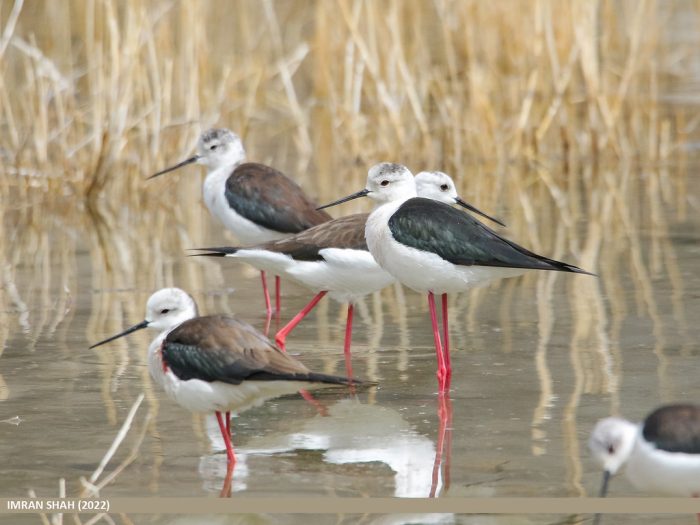
Image Source
The Black-winged Stilt is a wading bird species that can be found in various wetland habitats in Pakistan, including marshes, lakes, and ponds. It has a distinctive appearance, with long pink legs and a thin black bill. The body plumage is mostly white, with black wings and a black cap on the head. During the breeding season, the black cap extends into a long, narrow stripe that runs down the back of the neck.
These birds are highly adaptable and can be found in both freshwater and saltwater habitats. They feed on small aquatic invertebrates such as insects, crustaceans, and mollusks. The Black-winged Stilt is a migratory bird in Pakistan and is present in the country from October to April. During this time, they can be observed in large numbers in wetland areas across the country.
The Black-winged Stilt is a social bird that is often found in flocks. They have a unique courtship display, where the male will approach the female with a stick or piece of grass in his bill, which he then passes to the female. If she accepts, the pair will mate and build a nest together.
The conservation status of the Black-winged Stilt in Pakistan is currently listed as the Least Concern by the IUCN. However, the destruction of wetland habitats due to human activity and climate change poses a threat to the population of this species. Conservation efforts to protect wetland habitats are important for the survival of the Black-winged Stilt and other wetland species in Pakistan
Red-wattled Lapwing
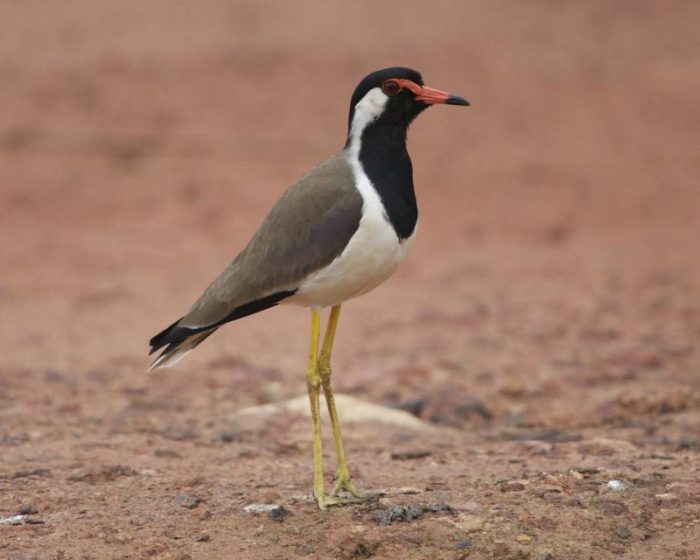
Image Source
The Red-wattled Lapwing (Vanellus indicus) is a large, ground-dwelling bird that is found in various habitats across Pakistan, including grasslands, wetlands, agricultural fields, and urban areas. It is easily recognizable by its distinct call, which sounds like “did-he-do-it” and the bright red fleshy wattle on its face.
This species has a brownish-grey back, a white belly, and black and white wings. It also has a distinctive black crest on its head, a black breastband, and a red, fleshy wattle on its face that is bordered by a white band. The legs are long and yellow, and the bill is black.
Red-wattled Lapwings are known for their distinctive calls and aerial displays during breeding season. They are also territorial birds and will defend their nesting area aggressively against any perceived threats. These birds feed on insects, small invertebrates, and occasionally seeds and fruits.
In Pakistan, the Red-wattled Lapwing breeds from February to August and lays its eggs in shallow scrapes in the ground. The eggs are well-camouflaged and blend in with the surrounding ground cover. The chicks hatch after about 4 weeks and are precocial, meaning they are able to move around and feed themselves shortly after hatching.
Rock Pigeon
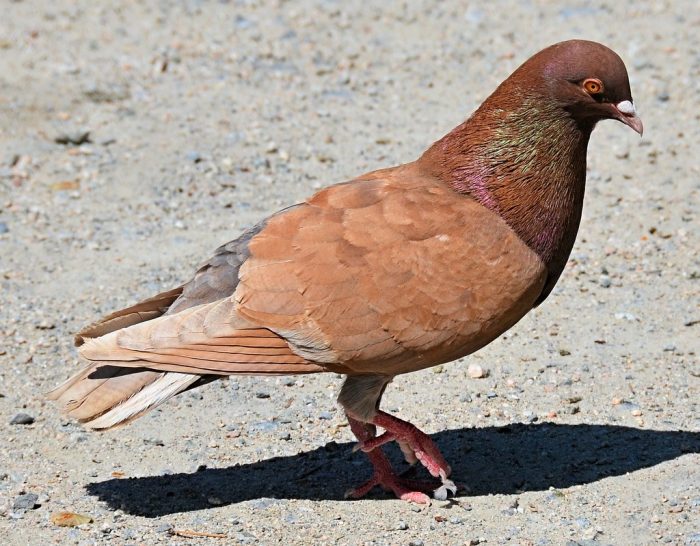
Image Source
Rock Pigeon, also known as the Common Pigeon, is a species of bird that is found all over the world, including in Pakistan. They are often seen in urban areas and can be easily recognized by their plump body, short neck, and a small head.
The Rock Pigeon has a grayish-blue plumage with two black bands on its wings. They have a distinctive iridescent patch on their necks that shines with different colors depending on the angle of light. They have red eyes, a small black bill, and pink feet.
Rock Pigeons are known for their cooing call, which is often heard in the early morning and at dusk. They feed on seeds, grains, and small insects. They are known to form large flocks, especially in urban areas, where they can be seen perched on buildings or flying overhead.
Rock Pigeons are considered to be a pest in some areas due to their tendency to cause damage to buildings and monuments. However, they are also a common sight in parks and gardens and are enjoyed by many birdwatchers.
Eurasian Magpie
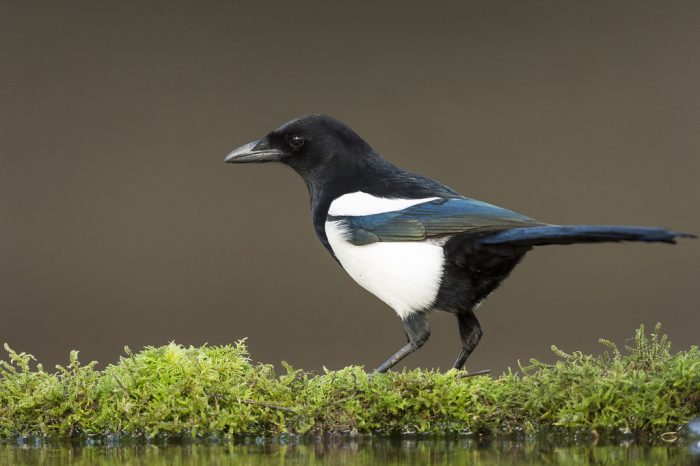
Image Source
The Eurasian Magpie (Pica pica) is a common bird species found in Pakistan, primarily in the northern and western parts of the country. It is a member of the crow family and is easily recognized by its striking black and white plumage.
Eurasian Magpies are about the size of a crow, with a length of around 45-60 cm and a wingspan of 52-62 cm. They have black feathers on their head, wings, and tail, and white feathers on their neck, belly, and shoulders. They also have a long, pointed black beak and a short, rounded tail.
These birds are highly intelligent and social, often seen in small groups or pairs. They are known for their ability to imitate sounds and even human speech and have been observed using tools in the wild.
Eurasian Magpies are omnivorous, feeding on a variety of foods including insects, small mammals, eggs, fruit, and carrion. They are also known to steal food from other birds and animals.
In Pakistan, Eurasian Magpies can be found in a range of habitats, including forests, farmland, and urban areas. They are considered to be of the least concern in terms of conservation status and are generally seen as beneficial to humans due to their diet, which includes harmful insects and rodents.
Also Read:
- Birds with Red Breast
- Species of Migratory Birds in Pakistan
- Birds with yellow bellies
- Birds with yellow tails
- What do crows eat
- Small birds with red heads
- Black birds with orange wings
- Do penguins have knees
- Grackles vs starlings
- Black birds with yellow heads
- Gray birds with yellow bellies
- Blue and red birds
- Brown and White birds
- Are birds warm blooded
- Yellow birds with black wings
- Black birds with white spots
- Red Peacock
FAQs on the species of birds in Pakistan:
What is the total number of bird species found in Pakistan?
There are over 700 bird species found in Pakistan, making it a birdwatcher’s paradise.
What are some of the most common bird species found in Pakistan?
The most common bird species found in Pakistan include the House Sparrow, Indian Peafowl, Common Myna, Red-vented Bulbul, and White-throated Kingfisher.
What are some of the rare bird species found in Pakistan?
Some of the rare bird species found in Pakistan include the Siberian Crane, Indian Skimmer, and Pallas’s Fish-eagle.
What is the best time of the year for birdwatching in Pakistan?
The best time for birdwatching in Pakistan is during the winter season, from November to February when a large number of migratory bird species arrive in the country.
What are some of the best places for birdwatching in Pakistan?
Some of the best places for birdwatching in Pakistan include the Khunjerab National Park, Margalla Hills National Park, Lal Suhanra National Park, and the Cholistan Desert.
Are there any bird sanctuaries in Pakistan?
Yes, there are several bird sanctuaries in Pakistan, such as the Kirthar National Park, Hingol National Park, and the Rann of Kutch Wildlife Sanctuary.
Are there any endemic bird species found in Pakistan?
Yes, there are several endemic bird species found in Pakistan, including the Sind Woodpecker, Sind Sparrow, and the Grey Hypocolius.
What is the status of bird conservation efforts in Pakistan?
Bird conservation efforts in Pakistan have been improving in recent years, with the establishment of bird sanctuaries, conservation organizations, and research institutions dedicated to the protection of bird species and their habitats.

